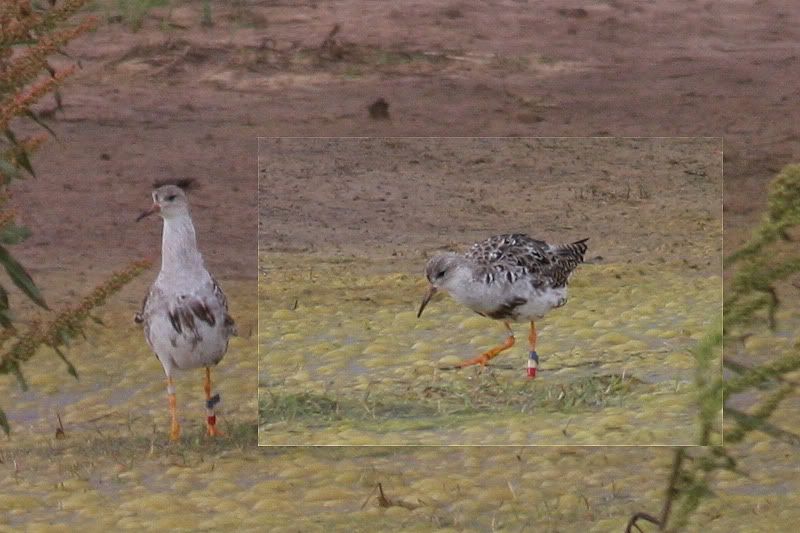Thanks to Jo Fisher for forwarding on the details of the above bird....
Details on the colour ringed Ruff are as follows:
Colorcode: B3WRYY Name Jaap Strikwerda 2nd
Ringnr: 1508488 Date Catch: 19-3-2009 Catching Location: Workum, Workumerbinnenwaard-
Noord
The Netherlands 52.59.28 N 05.24.08 E
Sightings of this bird:
Date(d/m/y Location Observer 2nd Observer 3rd Observer
21-3-2009 Workum, Workumerbinnenwaard-Noord Marianne McGhie Katharine Bowgen
The Netherlands 52.59.28 N 05.24.08 E
22-3-2009 Workum, Workumerbinnenwaard-Noord Jan Kramer
The Netherlands 52.59.28 N 05.24.08 E
23-3-2009 Workum, Workumerbinnenwaard-Noord Pedro Lourenco
The Netherlands 52.59.28 N 05.24.08 E
25-3-2009 Workum, Workumerbinnenwaard-Noord Katharine Bowgen Tamas Kiss
The Netherlands 52.59.28 N 05.24.08 E
25-3-2009 Workum, Workumerbinnenwaard-Noord Katharine Bowgen Tamas Kiss
The Netherlands 52.59.28 N 05.24.08 E
25-3-2009 Workum, Workumerbinnenwaard-Zuid Theunis Piersma
The Netherlands 52.58.23 N 05.25.01 E
6-4-2009 Stavoren, Noordermeerpolder Marianne McGhie Lucie Schmaltz
The Netherlands 52.53.32 N 05.23.14 E
19-7-2009 Boston, Frampton Marsh Jo Fisher
United Kingdom 52.56 N 00.01 E
dinsdag 29 september 2009 Pagina 1
Below and on our website you can find more information about this project
and other (bird) research at the University of Groningen and read the latest
Ruff-Newsletter (April 2009):
http://www.rug.nl/biologie/onderzoek/on ... e/onderzoek/researchStudies/migratimmune
Jos Hooijmeijer
-----------------------------------------------------------
RESEARCH OUTLINE
Colour-ringed Ruffs and Black-tailed Godwits
In the spring of 2004 the University of Groningen, (The Netherlands),
started a long-term research-project on the relationship between breeding
range and migration-patterns in waders. There seems to be a general pattern
that arctic breeders predominantly spend the winter in marine habitats,
whereas species breeding south of the tundra desert belt tend to winter in
more freshwater habitats. The driving force behind this is supposedly the
ability of a species´ immune system to deal with diseases, which are more
likely to occur under warm/ freshwater conditions. Red Knot (Calidris
canutus) and Bar-tailed Godwit (Limosa lapponica) are examples of the
arctic/marine species-group, whereas related species as Ruff (Philomachus
pugnax) and Black-tailed Godwit (Limosa limosa) are representatives of the
opposite strategy.
The Black-tailed Godwit is one of the few bird species for which the
Netherlands has an important international responsibility, because about 80
% of the EU-population breeds here. Numbers have declined strongly during
the last few decades, mainly as a consequence of agricultural
intensification. There is a large amount of background knowledge on
population trends in different parts of the country, but apart from some
aspects, most of their ecology is not well known. We are interested in
timing and transition from migration to breeding, the variation in breeding
plumage, mate choice, immuno-competence, chick- and adult-survival, etc.. We
hope that the outcomes of our research will also contribute to the
conservation of this beautiful species.
Ruffs are close to extinction as a breeding bird in The Netherlands, but
large numbers stopover in the Dutch grasslands during north- and southward
migration. Although peak-numbers are quite well known, there is little
information on staging-time. This makes it difficult to estimate the total
population size of Ruffs using the Dutch meadows during spring migration.
Ruffs staging in The Netherlands fan out to an enormous boreal breeding
range with recoveries as far away as eastern Siberia. Most Ruffs spend the
non-breeding season in West Africa, but some winter as far north as The
Netherlands. Although there is evidence that males and females use different
flyways, no evidence exists for population structuring of the kind known in
many other long-distance shorebirds. This is surprising, as the timing of
migration and reproduction varies strongly between different parts of the
range. Furthermore, we will try to unravel the mysterious third
mating-strategy in Ruffs: the faeder.
In order to be able to address these questions, a colour-marking programme
was started in 2004. Until now more than 4000 Ruffs and 450 Black-tailed
Godwits were colour-ringed, of which we have received in the past years 6600
and 3500 sightings respectively from over 300 observers and from more than
175 locations in 18 countries! We aim to continue colour-marking birds in
the coming years.
Both species wear a metal ring, 4 colour-rings (2 per leg) and an additional
colour-flag (colour-rings and flag without inscriptions). Used colours are:
yellow, blue, red and white. The metal ring is not a part of the code and
therefore of no importance.
We hope that many birdwatchers will take the effort to send in their
observations of colour-ringed birds. In return we will inform you at least
once a year about the research-proceedings and the bird(s) you have seen.
Besides the exact position of flag and rings we are of course also
interested in the re-sighting date and place (if possible with
co-ordinates). Supplementary information on group-size, behaviour, habitat
and the number of birds you checked for rings is also very welcome!
~~~~~~~~~




